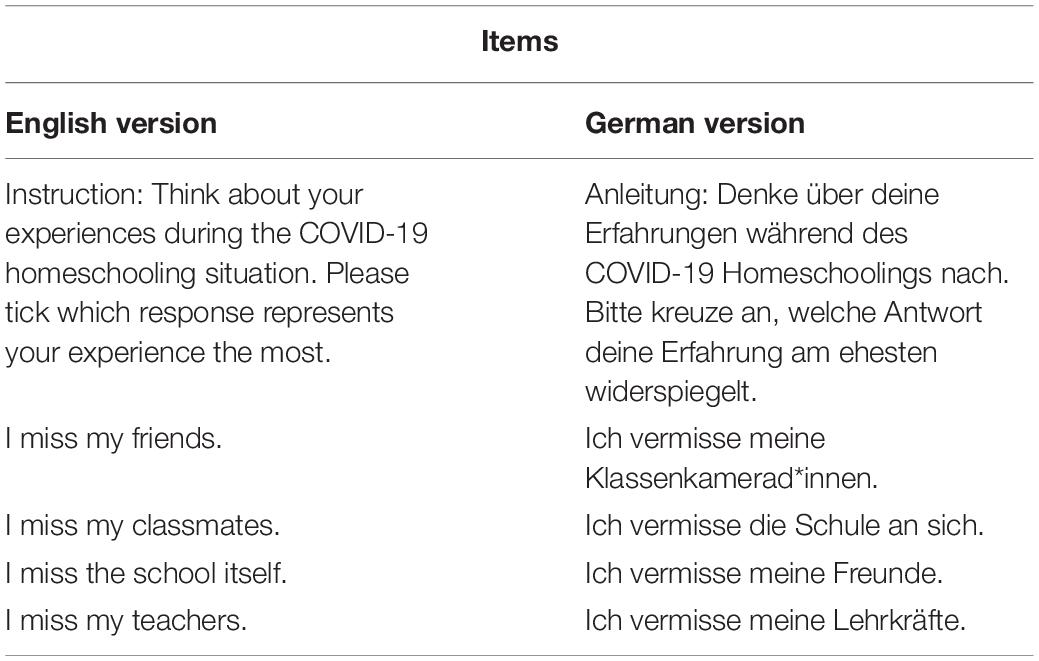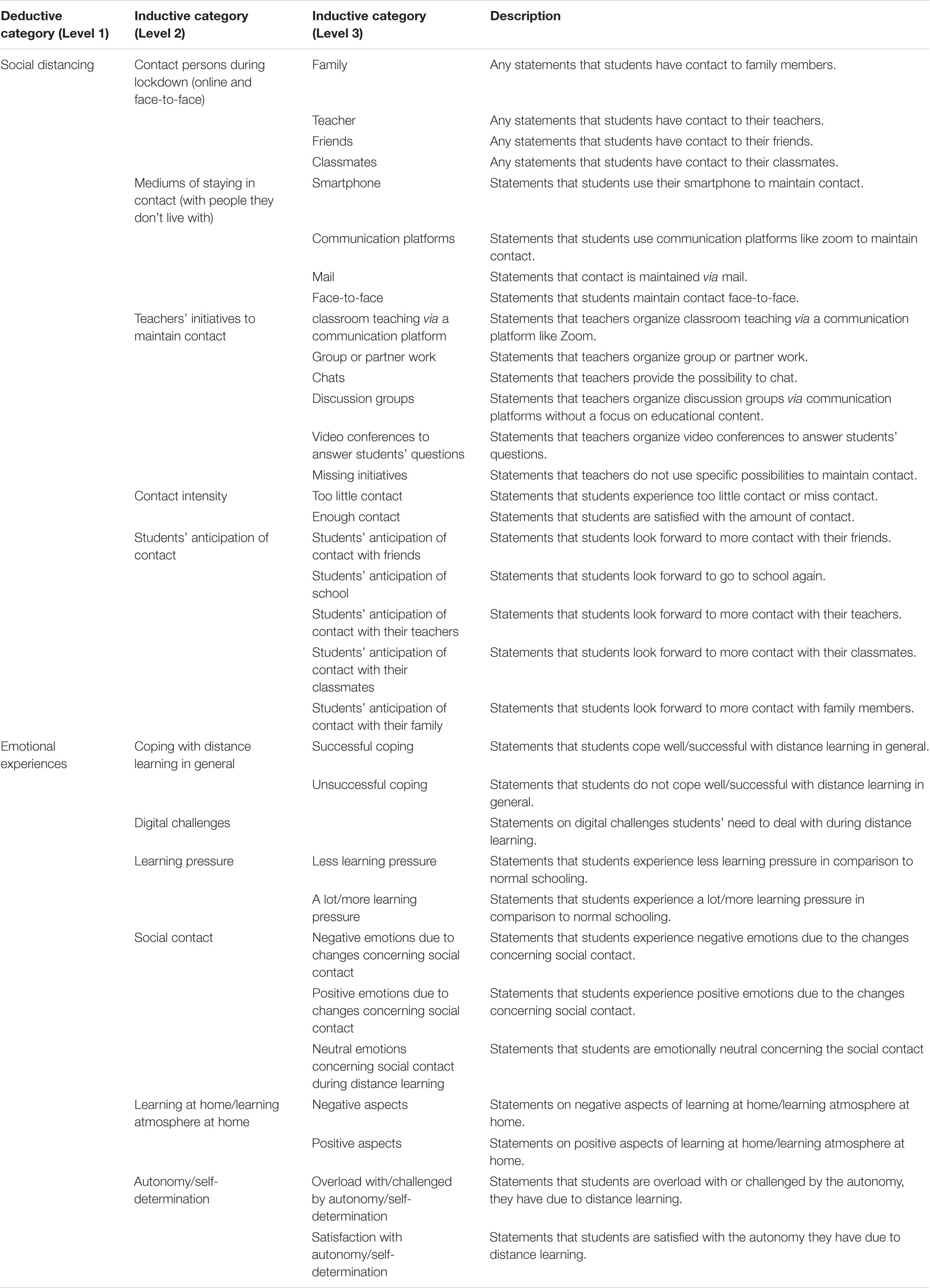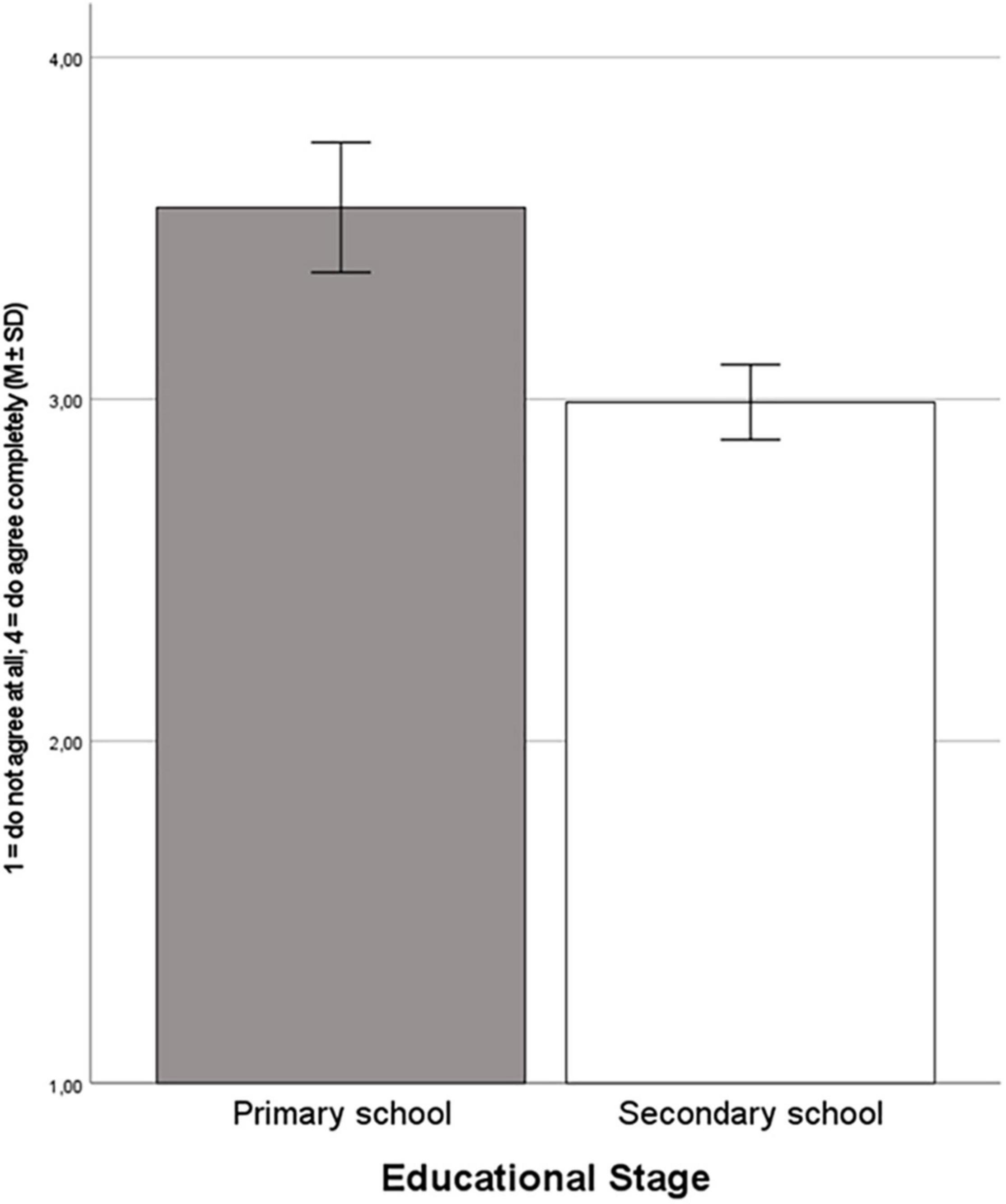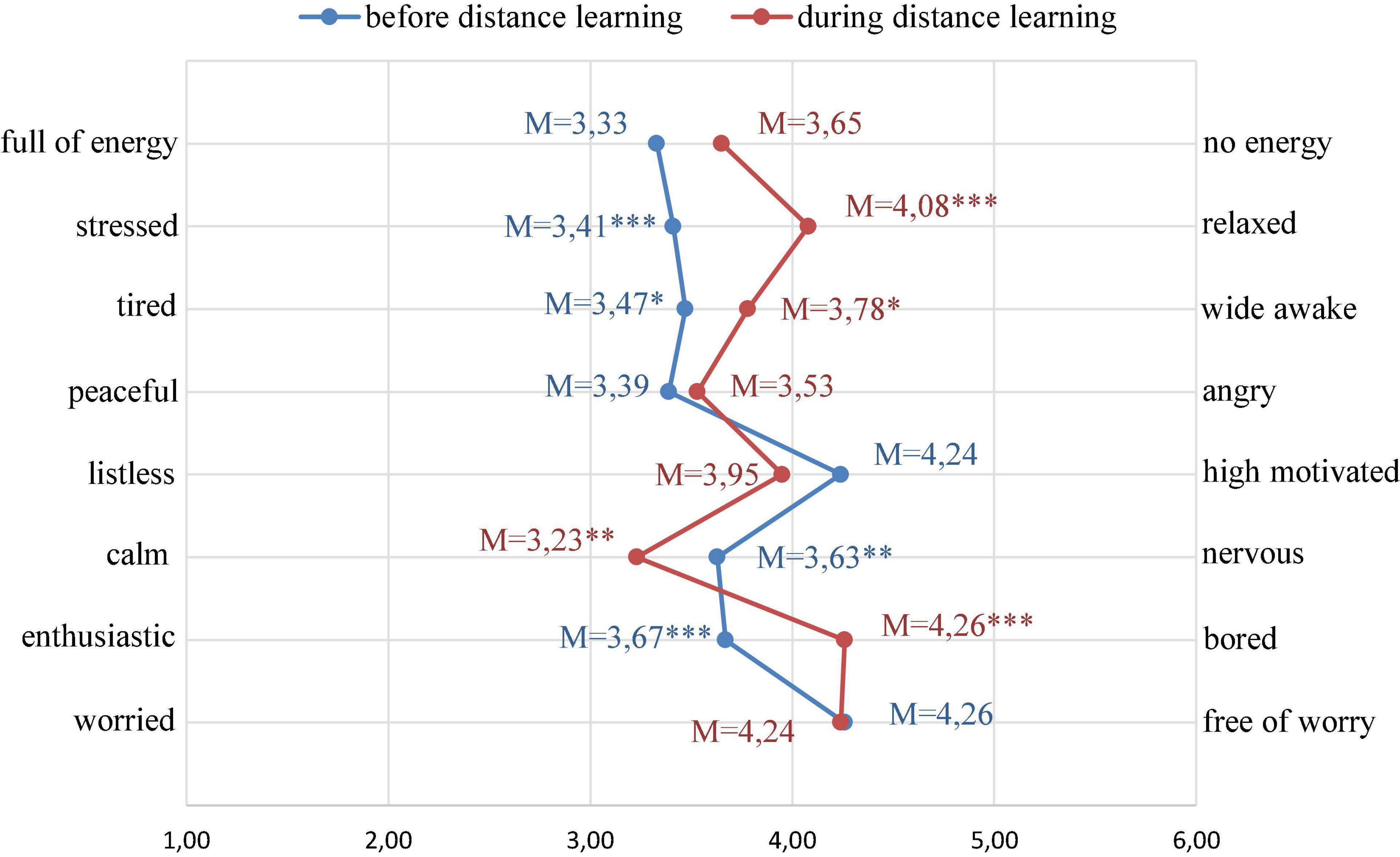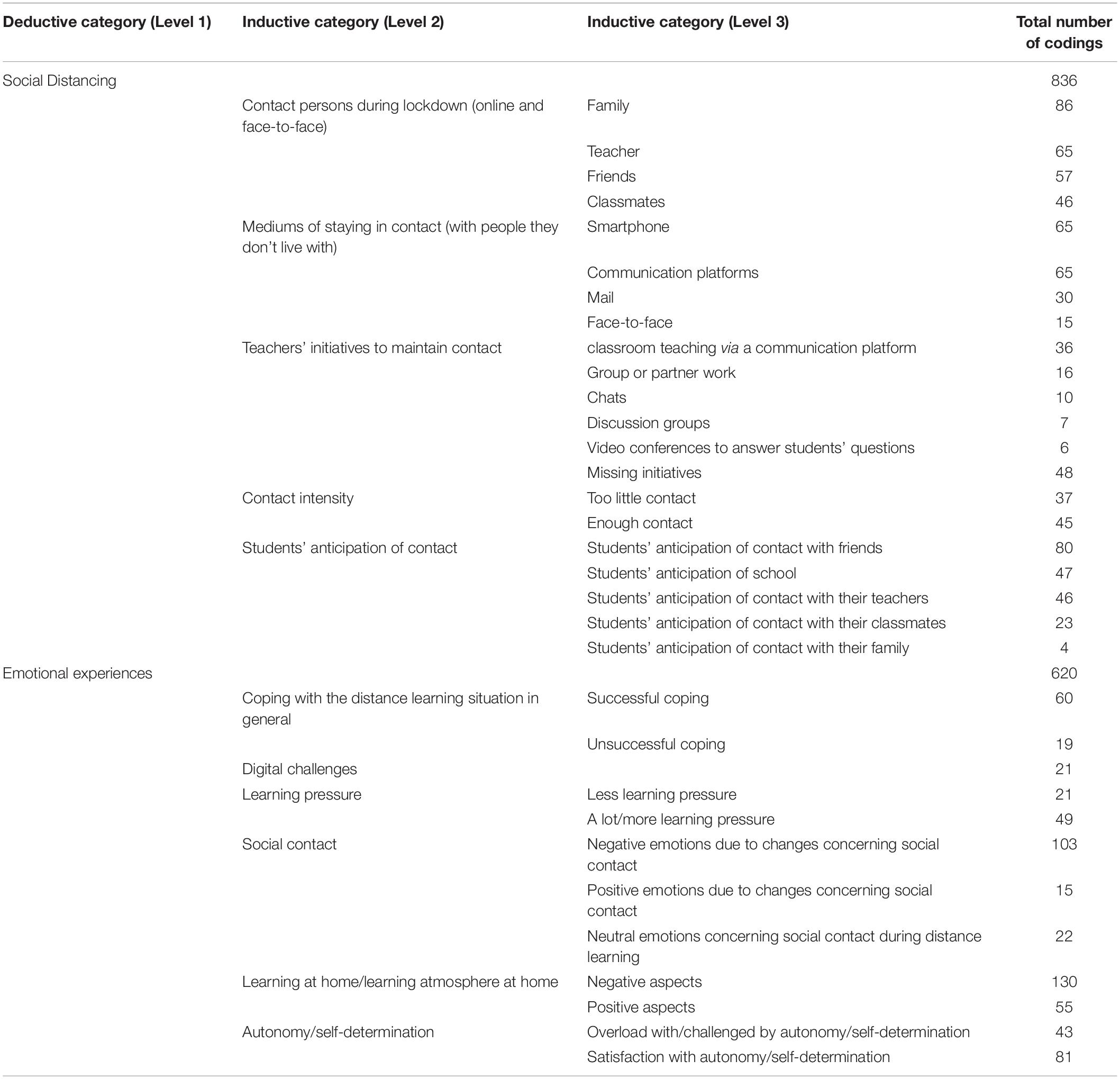- 1Center for Teacher Education, University of Vienna, Vienna, Austria
- 2Professional School of Education, Humboldt University, Berlin, Germany
- 3School of Psychology, University of Monterrey, Monterrey, Mexico
- 4Center for Teacher Education, University of Trier, Trier, Germany
- 5Department of Education, University of Vienna, Vienna, Austria
- 6Research Focus Optentia, North-West University, Vanderbijlpark, South Africa
The COVID-19 pandemic has led to far-reaching changes in various aspects of students’ lives. In the particular case of the educational field, classroom teaching was drastically shifted to a distance learning format. Consequently, students needed to deal with a completely different everyday school life. Learning was carried out online, which implied that students could not see some of their regular, important social contacts such as teachers, classmates or friends. It is already proven that such social distancing measures had impacts on students’ emotional experiences during the lockdown. Following a mixed-methods concurrent single-phase design, this study examined students’ perceptions of social distancing and their emotional experiences during the first school lockdown in Austria. Data from an online survey (n = 263 students) and from qualitative interviews (n = 56 students) were analyzed. The results show that distance learning drastically reduced interaction among students and between students and their teachers. Furthermore, the results indicate negative emotional experiences due to less social contact, increased learning pressures, and less structure. However, findings revealed that students also experience and perceived positive emotional experiences during distance learning because of more freedom, autonomy, and to some extent, less performance pressure. Based on the findings, the present study discusses possible perspectives on how to support students during and after distance learning, as well as further lines of research.
Introduction
The Sars-CoV-2 (COVID-19) pandemic led to radical changes in the daily lives of people all over the world, with a particular impact on the daily school lives of students, teachers, and parents with school-aged children. With the abrupt school closures worldwide, radical changes concerning daily school life resulted in a worldwide education crisis affecting more than 1.5 billion students around the world (Education International, 2020; Huber and Helm, 2020a; OECD, 2020).
As in many other countries, the Austrian government decided to enforce restrictions concerning various aspects of life in order to flatten the curve of infections. In March 2020, schools were closed abruptly, and classroom teaching was shifted to distance learning. The teachers were asked to provide learning material online or in analog form, so that the students were able to study at home by themselves (Bundesministerium für Bildung, Wissenschaft und Forschung., 2020). Strict rules for social distancing were formulated, resulting in a massive reduction of social interaction in general (Bundesministerium für Soziales, Gesundheit, Pflege und Konsumentenschutz, 2020b). With these sudden and unprecedented changes, researchers pointed at the potential impact of social distancing measures and distance learning on students’ emotional experiences and wellbeing, in particular on younger students (Flack et al., 2020). Indeed, research into educational stakeholders conducted within the start of the first lockdown indicated that neither students, teachers, nor parents were prepared to deal with this unexpected situation and cope with such new challenges (Letzel et al., 2020; Wyse et al., 2020).
Within the context of the massive effects school closures had, particularly on students, the present study focuses on students’ perceptions of social distancing and their emotional experiences. Although the term “social distancing” is used quite often within the context of the COVID-19 pandemic, the theoretical construct and operationalization of it is still being discussed. In line with statutory measurements to minimize the number of infections, social distancing can be defined as maintaining physical distance from other people (Bundesministerium für Soziales, Gesundheit, Pflege und Konsumentenschutz, 2020a). The term is associated with isolation and quarantine (Souza et al., 2020). For the present study, social distancing is to be understood as the subjective, perceived distance to another person or to members of a group (Beck, 2020). Even when people need to stay away from each other, this does not lead automatically to a perceived larger social distance to fellow human beings. Other ways of keeping contact, like chatting, telephoning or the stronger contact with family may counterbalance the missing physical closeness to others (Adami et al., 2020; Saad and Gupta, 2020; Pozas et al., 2021). For instance, Letzel et al. (2020) indicated that students were well supported by their families but perceived a large distance from their teachers and missed their support during distance learning. Flack et al. (2020) highlighted that teachers assume that their students are socially isolated due to distance learning. Especially primary school teachers seem to worry about their students suffering from social isolation, since their students are not as used to utilizing digital tools as secondary school students are. A qualitative study, conducted in Mexico and Germany, involving both students and their parents, showed that Mexican students in particular found new (digital) ways to keep in touch with their friends while respecting the necessary physical distance (Pozas et al., 2021). Nevertheless, these new means of contact are not able to replace normal interaction, as students reporting missing physical interaction and in-person contact with their friends (Pozas et al., 2021).
Besides the perceptions of social distancing, students’ emotional experiences are of important research interest. Students’ emotions and their wellbeing have shown to have an impact on e.g., students’ academic performance (López et al., 2017). Thus, analyzing students’ emotional experiences during the COVID-19 pandemic may help in understanding the influences of these events and circumstances and may lead to new insights into how positive emotions can be elicited. Emotional experiences in general can be conceptualized as positive and negative affective activations (Schreiber and Jenny, 2020). A high level of activation is crucial for an affective activation to be considered either a positive activation or negative activation. An example of a high activation state with a positive affect, i.e., a positive activation, is being highly motivated or wide awake, whereas being nervous or worried are examples of a negative activation, or rather a high activation state with a negative affect (Schreiber and Jenny, 2020). According to Huber and Helm (2020a), the majority of students indicate experiencing stress due to distance learning. Despite the experience of stress, however, most of the students do not indicate specific challenges. Huber and Helm (2020a) took only challenges concerning learning into account, but not the challenge of social distancing. Flack et al. (2020) identified a risk for students’ educational and psychological wellbeing during distance learning from a teacher’s perspective. Other studies can confirm these findings of negative emotional experiences due to distance learning. Mælan et al. (2021) establish that students prefer face-to-face teaching and experience decreased wellbeing during distance learning. In another nationwide survey in the United States, 80% of the students indicate that the pandemic caused a decrease in their mental health, and 20% even indicate significant increases in stress, anxiety, disappointment, sadness, and loneliness or isolation (Active Minds, 2020). In contrast, results from Letzel et al. (2020) did not indicate a negative influence of distance learning on students’ wellbeing on a scale level. However, when analyzing on an item level, results indicated that distance learning provoked an increase in listlessness, boredom and worries, but also an increase of feeling energetic and awake due to more flexibility and more free time (Letzel et al., 2020). Styck et al. (2021) identified further stressors that students perceived and needed to cope with during distance learning: amongst the highest-rated were social isolation, the fear of falling ill or family members or friends falling ill, schoolwork (motivation for schoolwork, concentration, and fear of falling behind), and the cancelation of events (Styck et al., 2021). Gender and educational stage differences were found as well: female high school students experienced the most stress due to schoolwork, and high school students in general were more stressed than middle school students, and these, in turn, were more stressed than elementary school students due to schoolwork during distance learning. Independently from the educational stage, female students experienced higher stress levels concerning the fear of COVID-19 illness. Social isolation also stressed female high school students more than male high school students. At the elementary school level, no gender differences were found. The cancelation of events constituted more stress for female secondary school students than for male secondary school students as well (Styck et al., 2021). The finding, that female and/or older students experienced higher stress levels than male and/or younger students, could be confirmed by Demaray et al. (2021). They too established that female and/or older students reported more anxiety and depression symptoms during distance learning due to the COVID-19 pandemic (Demaray et al., 2021).
Purpose and Research Questions
Previously conducted research suggests that the influence of distance learning is multilayered and complex. However, further research is necessary to get a broader understanding of its impact, and a broader knowledge about the effects on students (Letzel et al., 2020). To generate a comprehensive insight into students’ perceptions of social distancing and their emotional experiences, the present study follows a mixed method approach (Creswell, 2009) and takes quantitative data from an online survey and qualitative data from interviews with students into account. The following research questions lead the data analyses:
1. How can students’ perceptions of social distancing and their emotional experiences during distance learning be described?
a. Do specific variables influence students’ perceptions of social distancing during the COVID-19 school lockdown (gender, educational stage)?
b. Is there a significant difference between students’ positive and negative activation before distance learning and during distance learning?
c. Do specific variables influence students’ emotional experiences during the COVID-19 school lockdown (gender; educational stage)?
2. What aspects characterize students’ perceptions of social distancing and their emotional experiences during distance learning?
In light of the aforementioned theoretical background, it can be hypothesized for the first research question that distance learning caused an impact on students’ perceptions of social distancing. For students’ emotional experiences, it can be expected that distance learning provoked negative emotions, and more specifically, less positive activation and more negative activation, as distance learning causes stress (Styck et al., 2021). Concerning gender and educational stage differences, previous research results suggest that female and/or secondary school students are more vulnerable than male and/or primary school students (Demaray et al., 2021; Styck et al., 2021). Thus, it is expected that female participants will report higher levels of negative activation.
Materials and Methods
The current study uses data from the COVID-19-related research project INCL LEA (Inclusive Home Learning during COVID-19), based at the University of Vienna in Austria. The project was developed in cooperation with the University of Trier in Germany and uses similar methods as the SchElLe project (Letzel et al., 2020). Furthermore, the INCL LEA project was realized in cooperation with the relevant local school boards and therefore has ethical approval. It uses a mixed-methods concurrent single-phase design, in which quantitative and qualitative data were collected at the same time (Creswell and Zhang, 2009).
Participants
The sample of the current study was derived from one measurement during the first lockdown of schools in spring 2020 in Austria. The quantitative sample consisted of 263 students with a mean age of 13.53 years (SD = 3.83; min = 6, max = 22). 34.2% of the participating students were male, 65% were female; 21.7% attended primary school, and 77.6% attended secondary school. The qualitative sample was composed of 56 students with a mean age of 12.54 years (SD = 3.422; min = 6, max = 18). 60.7% of the interviewed students were female, 39.3% were male; 30.4% attended primary school and 69.6% secondary school.
Measures
Students’ Experiences of Social Distancing Scale
Students’ experiences of social distancing were measured with a scale based on the work of Letzel et al. (2020). The scale was composed of four items based on a 4-point Likert scale ranging from 1 (do not agree at all) to 4 (do agree completely) (e.g., “I miss my classmates,” Cronbach’s alpha α = 0.77). Please refer to Table 1 for the complete SESDS scale in both English and German language.
Students’ Emotional Experiences (Positive Activation, Negative Activation, and Valence)
To assess the students’ positive and negative activation, the short-form scale for positive activation, negative activation, and valence (PANAVA) scale was applied (Schallberger, 2005). The PANAVA scale measures students’ positive and negative activations by asking the participants to indicate their emotional state on a 7-stage scale between two opposite adjectives. There exist eight items of opposite adjective pairs, four items which represent the positive activations and four which represent the negative activations (Schreiber and Jenny, 2020). Positive activation is illustrated by the adjective pairs: “no energy—full of energy,” “tired—wide awake,” “listless—highly motivated,” and “bored—enthusiastic,” whereby the first adjective expresses a state of low positive activation, and the second adjective expresses a state of high positive activation. The items illustrating negative activation are: “relaxed—stressed,” “peaceful –angry,” “calm—nervous” and “free of worry—worried.” In each case, the first adjective indicates an emotional state of low negative activation, and the second adjective indicates an emotional state of high negative activation (Schallberger, 2005). Previous research gives evidence that the PANAVA scales possess acceptable internal consistencies (Cronbach’s alpha for the positive activation scale α = 0.86 and for the negative activation scale α = 0.86 in Schallberger (2005), Cronbach’s alpha for the positive activation scale α = 0.85 and for the negative activation scale α = 0.80 in Schreiber and Jenny (2020). For the sample of this study, Cronbach’s alpha for the positive activation scale before distance learning was α = 0.82; during distance learning α = 0.80; and for the negative activation scale, it was α = 0.79 before distance learning; and α = 0.79 during distance learning. The students’ reports on their positive and negative activation before distance learning occurred in a retrospective way, since the data collection took place during distance learning. Please refer to Table 2 for the instructions and the complete PANAVA scales in both English and German language.
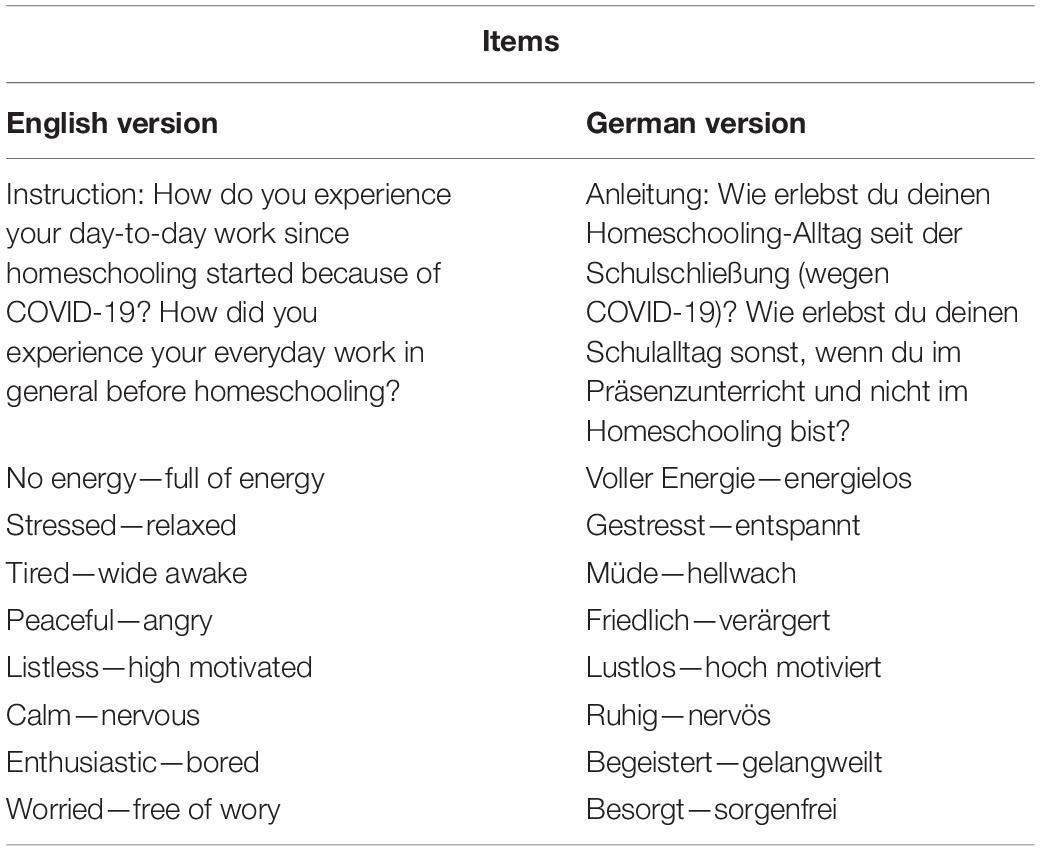
Table 2. Positive activation, negative activation and valence (PANAVA) scale (Schallberger, 2005).
Facets of Students’ Perceptions of Social Distancing and Their Emotional Experiences
The qualitative data were collected through semi-structured interviews. The interview guideline contained different thematic sections such as students’ perceptions of distance learning in general (e.g., “What do you like? What do you not like?”), staying in contact with teachers and friends (e.g., “How do you keep in touch with your teachers?”), and anticipations for the time after the lockdown (e.g., “What are you looking forward to when face-to-face teaching starts again?”).
Data Analyses
In order to develop an in-depth exploration of students’ perceptions of social distancing and emotional experiences during the first COVID-19 school related lockdown, this study implemented a mixed-methods embedded concurrent single-phase research design, where both qualitative and quantitative data were simultaneously collected (Creswell, 2009; Creswell and Zhang, 2009). Creswell and Plano Clark (2007) argue that using a mixed methods approach allows the capture of detailed information on the object of research by adding depth and context to quantitative results. Both types of data were analyzed separately; that is, quantitative data analyses were employed in order to explore research question 1, whereas qualitative data analyses were implemented for research question 2. Lastly, the findings were merged together in the results and discussion section. Thus, both forms of data are given equal emphasis throughout this study (Table 3).
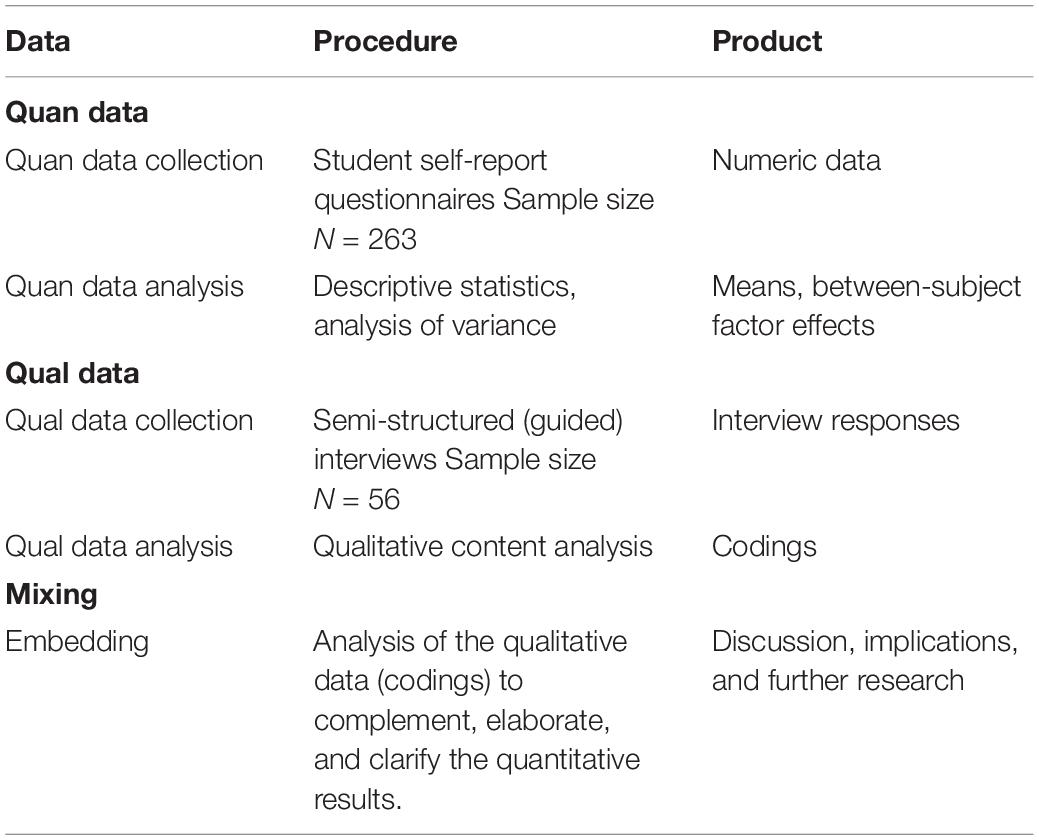
Table 3. Visual representation of the research process and data analyses (Creswell and Plano Clark, 2007; Creswell, 2009).
Quantitative Data Analyses
The quantitative data analyses were conducted in SPSS. To get detailed insights into research question 1—that is students’ perceptions of social distancing—one-sample t-tests were calculated separately for the scale’s four items. A two-way analysis of variance was used to identify the effect of gender (male vs. female students), the effect of educational stage (primary vs. secondary school students), and the interaction effect of gender and educational stage on students’ perceptions of social distancing. Therefore, the mean of all four social distancing items was applied. Furthermore, students’ emotional experiences were analyzed using their self-reports on positive and negative activation. In order to analyze the differences between students’ positive and negative activation before and during distance learning, paired sample t-test analyses were conducted at the scale level and at the item level. Gender and educational stage differences were explored by two one-way analyses of variance.
Qualitative Data Analyses
The interviews were recorded, transcribed and analyzed with qualitative content analysis according to Mayring (2014). The two main categories “social distancing” and “emotional experiences” were developed in a deductive way in order to explain the quantitative results more in depth. Consequently, a further differentiation of the categories was generated inductively. Table 4 shows the categorization matrix with main categories and subcategories on levels 2 and 3.
Results
Quantitative Analyses—Research Question 1
Students’ Perceptions of Social Distancing: Descriptive Results
In order to examine in detail students’ perceptions of social distancing during distance learning, item-level analyses were conducted. One-sample t-tests on each item (based on a scale of 1–4, where the theoretical mean is 2.5) were calculated. As seen in Table 5, all four items were rated significantly higher than 2.5 by the sample. According to Cohen’s d results, where an effect size of 0.20 is small, 0.50 is medium, and 0.8 or above is large (Cohen, 1988), it can thus be observed that the effect sizes of all four items are large. However, although all effect sizes are large, it is important to highlight that item 3 (“I miss the school itself.”) and 4 (“I miss my teachers.”) have the largest effect size.
Students’ Perceptions of Social Distancing: Gender and Educational Stage Differences
To explore the effects of gender and educational stage on students’ perceptions of social distancing, a two-way analysis of variance was conducted. A significant main effect of educational stage [F(1, 259) = 26.12, p < 0.001, ηp2 = 0.09] indicating that students’ perceptions of social distancing vary across primary and secondary school students (Figure 1). Specifically, primary school students reported higher levels than secondary school students. With regard to gender, no significant main effects [F(1, 259) = 2.61, n.s.] were reported, indicating that both female and male students have similar levels of social distancing. Lastly, a significant interaction effect between gender and educational stage [F(1, 259) = 6.64, p < 0.05, ηp2 = 0.03] (Figure 2) was found. It appears that only in primary education is there no notable difference between female and male students.
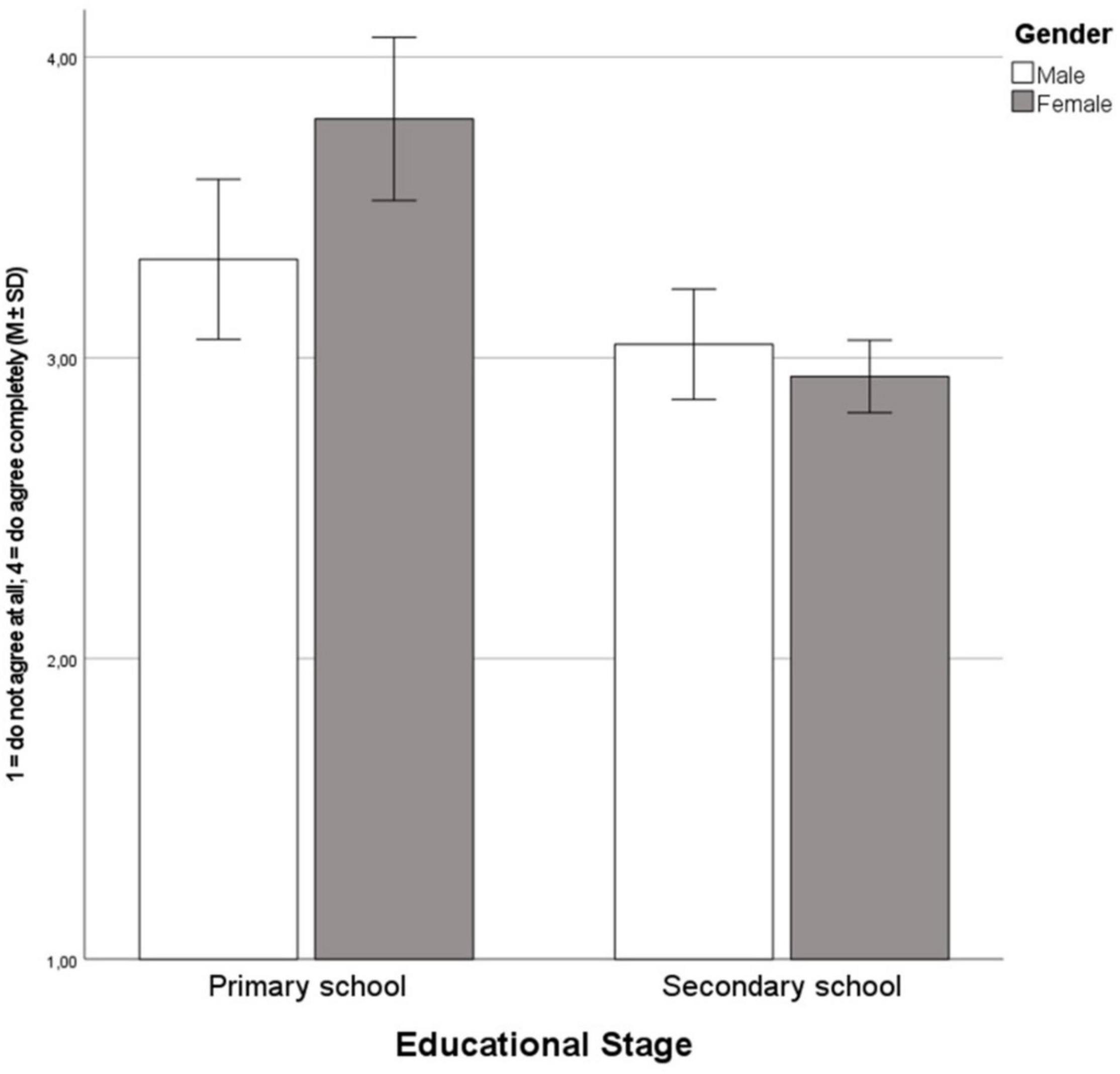
Figure 2. Interaction effect of gender and educational stage on students’ experiences of social distancing.
Students’ Emotional Experiences: Descriptive Analyses
With relation to students’ emotional experiences (positive and negative activation), t-tests analyses at the scale level indicated no significant differences between the situation prior to distance learning (retrospective perception) or during distance learning with regards to students’ positive activation [t(261) = 1.85, n.s.]. On the other hand, their negative activation before distance learning (M = 3.84; SD = 1.43) and during distance learning (M = 3.61; SD = 1.43) slightly decreased [t(261) = 1.98, p < 0.05]. Thus, overall, students’ emotional experiences were not affected by distance learning. However, paired sample t-test analyses at the item level revealed certain significant differences between the situations prior to distance learning and during distance learning. In particular, results showed that students were significantly more relaxed during distance learning [t(261) = −4.10, p < 0.001], more awake [t(260) = −2.07, p < 0.05], and calmer [t(261) = 2.93, p < 0.01], but, however, also more bored [t(260) = −3.97, p < 0.001] (Figure 3).
Students’ Emotional Experiences: Gender and Educational Stage Differences
To explore the effects of gender and educational stage on students’ emotional experiences, two one-way analyses of variance were conducted. The first analysis of variance indicated no main effects of gender [F(1, 259) = 1.10, n.s.] or educational stage [F(1, 259) = 3.61, n.s.], nor were any interaction effects between both factors [F(1, 259) = 2.58, n.s.] found for the dependent variable of students’ positive activation. Concerning students’ negative activation, a significant main effect of educational stage [F(1, 258) = 34.32, p < 0.001, ηp2 = 0.12] was found, indicating that students’ negative activation varies across primary and secondary school students (Figure 4). In detail, secondary school students reported higher levels of negative activation than primary school students. With regard to gender, no significant main effects [F(1, 258) = 2.76, n.s.] were reported, indicating that both female and male students have similar levels of negative activation. Finally, no significant interaction effect between gender and educational stage [F(1, 258) = 2.87, n.s.] was found.
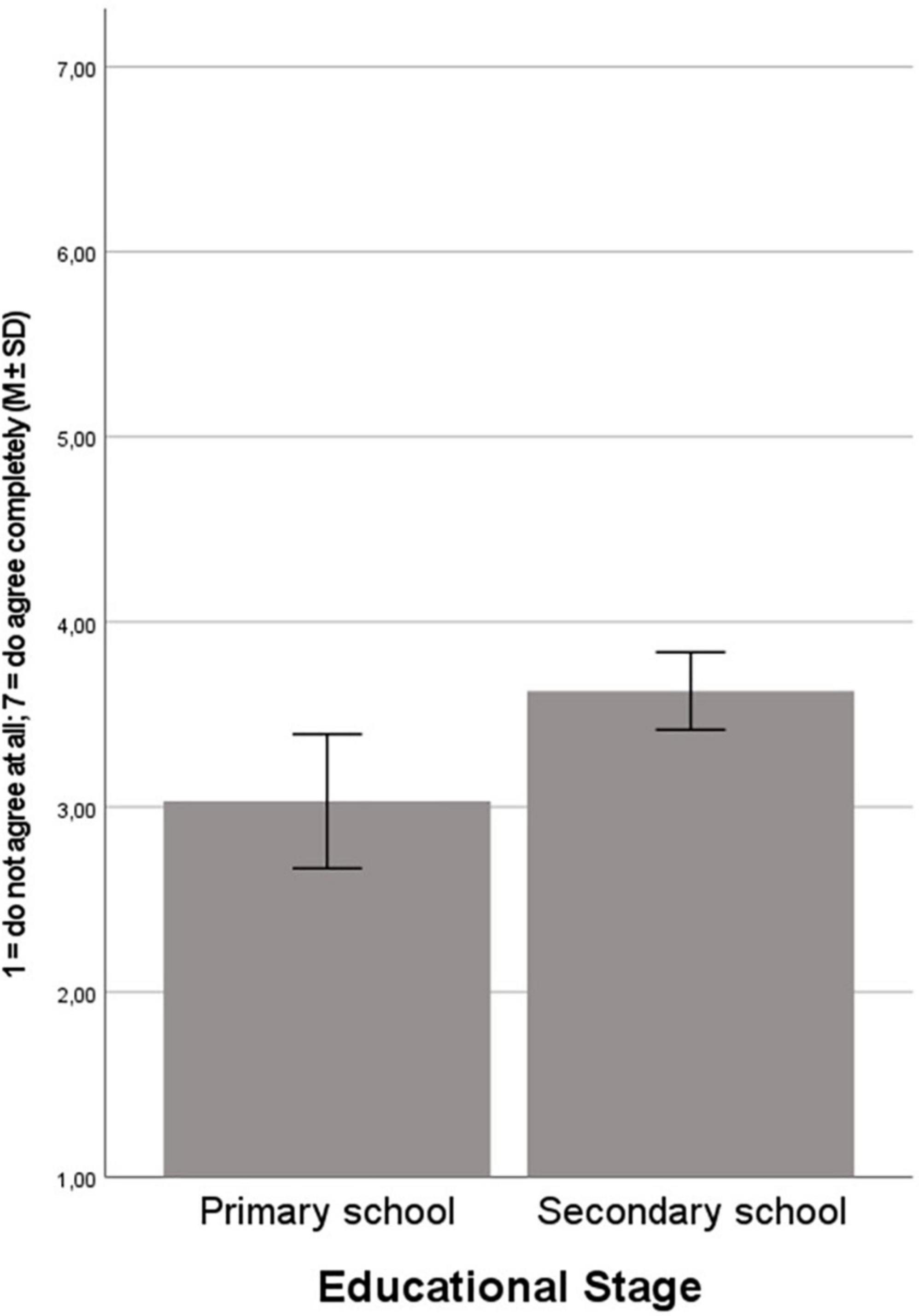
Figure 4. Main effect of educational stage on students’ negative activation during distance learning.
Qualitative Analyses
In order to gain deeper insight into the quantitative results, facets that characterize students’ perceptions of social distancing and their emotional experiences during distance learning were examined. Using the Computer Program MaxQDA, codings were extracted from the material. Codings, in this study, were full sentences or parts of sentences. Table 6 shows the total number of codings for each main and subcategory.
In order to ensure the goodness of the coding process, the intercoder reliability coefficient showed a conformity of 0.81 (Holsti, 1969). Concerning the first main category “Social Distancing,” 836 codings could be found in the material; 620 codings could be sorted into the second main category “Emotional Experiences.”
Students’ Perceptions of Social Distancing During Distance Learning
The first main category “Social Distancing” has been derived deductively from the theory, previous research, and the research questions. 836 codings in total were extracted from the data material for the main category “Social Distancing.” To analyze the data in detail, the main category has been extended into further subcategories inductively. A closer look at students’ contact persons during distance learning and mediums used for staying in contact has been taken, along with teachers’ initiatives to maintain contact with their students and between the students themselves, students’ perceptions of the intensity of contact, and the anticipation of contact.
Concerning students’ contact persons during distance learning, four different groups of persons could be identified: family (86 codings), teachers (65 codings), friends (57 codings) and classmates (46 codings). The decline in contact with teachers and classmates seemed to be replaced at least partly by more contact with family members, as can be confirmed by the following two quotes:
Interviewer: So, in the beginning was it difficult for you not seeing them [the classmates and friends] at all?
Student 1: Not really.
Interviewer: Why not?
Student 1: Because I have a little brother, I can also play with him.
Student 2: So, when I need help, I can go to my parents, or my brother helps me sometimes as well.
The number of codings (n = 86) showed family members to be the most important contact persons for students in the pandemic. However, the numbers also reveal that students had less contact with their classmates (n = 46), whom they see every day in presence-based teaching formats. Student 2 also seems to express that he or she is referring to family members when he or she needs help in homeschooling, which emphasizes the shifting of roles: family members took over the roles of teachers.
The family is mostly mentioned in the context of learning and assistance in learning or motivating to learn. Contact with teachers is maintained online within distance learning, and the same applies for contact with classmates. They exchange information about education and help one another. To maintain contact with persons they do not live with, students use their smartphones (65 codings) or communication platforms like Zoom or Skype (65 codings) to chat, phone, or video call. A less often mentioned medium for staying in contact is writing emails (30 codinigs). Emails are only used for contact with teachers. At least 15 codings were identified as face-to-face contact, mostly outside, and while heeding COVID-19 measures and restrictions.
Besides these general results concerning contact persons and mediums of staying in contact, teachers’ initiatives to maintain contact were analyzed in detail. Teachers organize classroom teaching via communication platforms like Zoom (36 codings), assign group or partner work (16 codings), provide the possibility to chat (10 codings), organize discussion groups via communication platforms without a focus on educational content (7 codings), and provide video conferences to answer students’ questions (6 codings). However, students express that they missed initiatives (e.g., activities or tasks) of their teachers that could have fostered social interaction in online learning. The category “missing initiative” contains 48 codings and functions as the biggest level three subcategory. Students indicate that group and partner work is missing during distance learning, as well as classroom teaching via an online platform, since not all teachers use this opportunity within distance learning.
Moreover, students reported huge differences in the contact intensity maintained by their teachers.
Interviewer: Is the amount of contact enough for you? Or is it too little or too much?
Student 3: Depends a lot on the teacher. There are some teachers I don’t have any contact with, I get the assignment and I send it back to them. You don’t get a lot of feedback from some teachers. That’s also a problem. Lots of other, younger teachers, who are very active at the moment, they write you long feedback, what you should change, what you can improve. Depends a lot on the person.
Interviewer: Do you have contact with your teachers?
Student 4: Not at all.
Interviewer: Not at all?
Student 4: No.
Interviewer: So, calling or chatting?
Student 4: No, nothing.
Interviewer: Is that too little contact for you or is it okay for you like that?
Student 4: It’s good for me like that.
While some teachers seem to be quite willing to maintain contact with their students during distance learning (see Student 3), others did not put much effort into it from the perspective of the students, as can be seen in the statement of Student 4. The statements concerning the contact intensity were sorted into the two subcategories: “too little contact” and “enough contact.” Even though the amount of contact between teachers and students varies significantly, some of the students indicate being satisfied with the amount of contact, no matter whether they have once a week, several times per week, or no contact at all with their teachers. 45 codings were found for the category “enough contact” and 37 codings were found for the category “too little contact.”
Despite the satisfaction with the contact intensity of many students, the anticipation of contact when the schools open again is huge. The most codings were found for the subcategory “students’ anticipation of contact with their friends” (80 codings). Even if they are maintaining contact through social media, students appreciate direct personal contact a lot and do look forward to it.
Student 5: But I’m really looking forward to seeing my friends, because it’s something else when you can talk face-to-face.
Furthermore, students were looking forward to going to school again (47 codings) and to having closer contact with their teachers (46 codings). They explain their anticipation of going to school and of seeing their teachers again by referring to structured, everyday life as well as the explanations they get from the teachers.
Student 6: So, it’s always quite enjoyable to be at school with all the teachers and so on. I miss that. Just normal lessons with the teachers, you can cooperate and get everything explained. I’m missing that.
Learning seems to be easier when the teachers predefine the structure and explain it face-to-face to the students. The students can react directly, and the face-to-face interaction works better without any time delay. Students look also forward to some subjects like sports or art, which are not represented in distance learning. Spending time together with their classmates during the lessons and the breaks is another anticipation students indicate within the interviews. 23 codings were found for the subcategory “students’ anticipation of contact with their classmates.” A small number of students also mention family members they are looking forward to seeing again (4 codings).
Emotional Experiences
Students’ emotional experiences during distance learning represent the second main category. 620 codings could be extracted from the material. To analyze students’ emotional experiences in detail, subcategories were established inductively. The data material suggests a closer look at students’ ability to cope with the whole situation in general, digital challenges, the experienced learning pressure, social contact, learning at home and the learning atmosphere at home, as well as students’ experiences with autonomy and self-determination.
Students mostly indicate that they cope well and successfully with the distance learning situation. 60 codings were identified for the subcategory “successful coping,” while only 19 codings were found for the subcategory “unsuccessful coping.” Students who do not cope successfully with distance learning in general explain their negative feelings with regards to boredom, difficulty learning and studying by themselves, with technical challenges or with sadness and demotivation caused by the COVID-19 pandemic. On the contrary, though, there are students who prefer distance learning over the normal teaching situation at school.
Interviewer: How do you cope with distance learning in general?
Student 7: Very good. It works really well. It is even more fun than at school.
Interviewer: Really? That’s nice. Why do you think so?
Student 7: I don’t know. It’s just more pleasant.
The other categories (digital challenges, learning pressure, social contact, learning at home/learning atmosphere at home, autonomy/self-determination) give deeper insights into students’ emotional experiences and may explain their positive or negative feelings. Due to the fact that the majority of students claim that they cope successfully with the situation, it is surprising that the material also offered a lot of negative emotional experiences. Students need to face several digital challenges (21 codings). Missing or bad digital conditions and a lack of experiences with computers or online platforms complicate distance learning for some students. Furthermore, the usage of several different communication channels and online platforms is confusing, annoys the students, and makes distance learning unnecessarily complicated from their point of view.
Concerning learning pressure during distance learning, 21 codings indicate that students experienced less learning pressure during distance learning in comparison to normal schooling. Students reported that there were no tests or exams, less of a workload, more free time, and the possibility to create one’s own timetable, which provoked less pressure. However, 49 codings suggest that students experience a lot or even a great deal more learning pressure during distance learning than during normal schooling because of the necessity of learning and coordinating all of the different assignments by themselves. Some students report a larger workload as well.
Regarding the category “learning atmosphere/learning at home,” hints can be found that point at negative emotional experiences, as 130 codings describe negative aspects of learning at home. Bad learning conditions at home refer mostly to difficulties the students report in studying and understanding everything by themselves, without the explanations of teachers or the possibility of asking them when something is not clear. Students miss their teachers’ feedback, report a bad organization of the teachers among each other and are annoyed by the need to spend so much time in front of the screen. Furthermore, technical problems or other distractions in their own rooms can impair the learning atmosphere at home. However, some students (55 codings) also report that they had a good learning experience at home; some experience the learning atmosphere being more comfortable than at school. Some students appreciate learning by themselves because they can work more efficient and independently from their classmates. They indicate that working at their own speed, being able to structure everything by themselves, and the missing classroom disruptions as advantages of distance learning. Students who receive help from their parents highlight the 1:1 support of their parents as a positive benefit, as a teacher also needs to support at least 20 other students at school.
The COVID-19 pandemic and distance learning affected how students could maintaining social contact. Many negative emotions (103 codings) can be associated with the reduction of social contact, but some neutral (22 codings) and positive (15 codings) emotions were also revealed. The following quote shows some positive emotions regarding social contact during distance learning:
Student 8: […] that you can stay at home without the feeling you’re missing something, that’s very pleasant. Especially nowadays, I don’t know, but there are every now and then meetings with friends, and you kind of feel obliged to go there, because you don’t want to miss something. And now, you can just stay at home without the feeling you miss something, that is really, really pleasant.
Students’ statements represent the reasons for the positive emotions. Students feel less social stress, are able to compensate for the missing direct contact with contact via online platforms, and appreciate team spirit of their class during distance learning. Nevertheless, the negative emotions concerning social contact during distance learning obviously dominate. Students miss their friends, their classmates, and their teachers. They prefer learning together instead of doing all of their assignments alone, and emphasize the difference of face-to-face contact vs. contact via online platforms.
More autonomy and self-determination are mostly associated with positive emotional experiences. 81 codings were explored for the subcategory “satisfaction with autonomy/self-determination,” whereas 43 codings were explored for the subcategory “overloaded with/challenged by autonomy/self-determination.” On the one hand, the higher level of autonomy during distance learning is challenging for the students and causes stress, because they are not used to structure and must organize everything by themselves. Some students have difficulty motivating themselves to study. On the other hand, many students appreciate the higher level of autonomy. They are happy about being able to do what they want when they want to do it, and report having more time for other activities besides studying.
Student 9: What I like a lot is that I can do my work when I feel more or less like working. And that I can organize all by myself when I do what.
Some students also highlight the increase of independence due to the challenges of distance learning and describe it as good preparation for their future.
Embedded Discussion
The COVID-19-related school closures had massive effects on people’s daily lives, but particularly on students’ learning and emotional experiences. Against this backdrop, this paper reports on a mixed-methods concurrent single-phase design aimed at an in-depth investigation of students’ perceptions of social distancing and their emotional experiences during distance learning.
Overall, quantitative and qualitative data indicate that students missed their friends, classmates, schools, and teachers. However, the quantitative results show that Austrian students missed their teachers and schools in particular. This was also mirrored within the qualitative data. Although, the highest number of codings within the category “students’ anticipation of contact” is of course in the context of meeting their friends again; “students’ anticipation of being back in school” (n = 47 codings) and “having contact with their teachers” (n = 46 codings) were the two categories with the second highest codings. Moreover, the qualitative results also indicate that students reported missing initiatives of contact (n = 48 codings) from their teachers. Additionally, the quantitative analysis revealed that primary school students perceived higher levels of social distancing compared to secondary school students. This result is consistent with previous research, which has shown that primary school students can be more affected by social distancing measures (Flack et al., 2020; Tomasik et al., 2021). Furthermore, no differences between female and male students were found. Interestingly, however, is the interaction effect that indicates that female primary school students experienced higher social distancing than male and female secondary school students. Such results are contrary to findings by Styck et al. (2021), which found that female school students reported higher levels, whereas male and female primary school students perceived social isolation at a similar level. Although further research is needed to explore these contrasting results in more detail, in general, previous research has indicated that female student participants experience higher levels of stress with regards to stressors of a more interpersonal nature (Hankin et al., 2007).
Concerning students’ emotional experiences, the quantitative data revealed no significant changes in students’ positive activation within distance learning at a scale level. Interestingly, a decrease in students’ negative activation during distance learning could be found. When looking at the item level, it could be shown that students felt more relaxed, awake, and calm, but also more bored. These findings were also confirmed by the qualitative data: most students indicated that they are coping successfully with distance learning. In addition, students reported feeling satisfied with the autonomy brought by distance learning as well as with the possibility of structuring their own day. With this unprecedented situation, students had little externally induced “pacing” (Lockl et al., 2021), and thus need to invest more effort in self-organizing their daily schedules. Therefore, it could be that these aspects might have led to more relaxation, wakefulness and calmness, and thus explain the decrease in negative activation. Nonetheless, the qualitative data extracted from the interviews also highlights students’ negative emotional experiences during distance learning (see quote from Student 5 and 6). According to the data, negative emotional experiences appear to be caused by more learning pressure, being overloaded with autonomy, motivational problems, and negative aspects of learning at home. According to Huber et al. (2020b), some of the greatest challenges for students were taking actual responsibility for their own learning processes. Thus, negative affective-motivational experiences, such as boredom, are to be expected. Furthermore, when comparing gender and educational stage differences in students’ emotional experiences within the quantitative analysis, no differences for positive activation are present, but differences for negative activation can be found: secondary school students have higher levels of negative activation, meaning they were more affected by distance learning than primary school students. Previous research on stress has indicated that older students, such as in the case of secondary school students, might have a better understanding of the impact of the crisis situation and as a result experience more stress (Groome and Soureti, 2004). Styck et al. (2021) studied primary and secondary school students’ stress resulting from the COVID-19-induced school closures. Their findings indicate that secondary school students reported significantly a higher mean of schoolwork-related stress. The qualitative data explored within the present study show a similar pattern of effects. A total number of 130 codings were extracted for the category of “negative aspects of learning at home” as well as 49 codings related to the category of “more learning pressure.” Taken together, it could be assumed that secondary school students experience more school and learning pressures while distance learning. Nonetheless, the qualitative data were not explored for differences across primary and secondary school studies. Thus, such educational stage differences should be explored with more detail in further research.
Limitations
While interpreting the present results, one has to keep in mind that this study has several limitations. First, the present study is based solely on cross-sectional results obtained from the first COVID-19-related school closure during the spring of 2020. Consequently, causality of the results cannot be determined. Further studies with a longitudinal design are required to investigate in detail how students’ perceptions of social distancing and emotional experiences have changed throughout the unpredictable COVID-19 pandemic. Second, given that the qualitative analyses did not explore potential gender and educational stage differences, in-depth differences obtained from the quantitative study could not be fully explained. A third limitation concerns the fact that the present study did not collect data on students with special educational needs (SEN). According to previous research, students with SEN were one of the most vulnerable and affected student groups throughout the course of the COVID-19-related school closures (Goldan et al., 2021; Thorell et al., 2021). Thus, further research should also explore students with SEN social distancing perceptions and their emotional experiences. Lastly, given the unprecedented situation caused by the school closures, students’ emotional experiences (e.g., positive and negative activation) were assessed through means of retrospective ratings. In this sense, given that this is not longitudinal data, it is possible that a recall bias may have influenced students’ retrospective perceptions (Scheer and Laubenstein, 2021).
Conclusion
Despite the limitations, the present study highlights the severe impact of distance learning on students’ perceptions of social distancing and their emotional experiences. Students experienced a drastic reduction in social interaction during the pandemic-induced school lockdowns. The main results show that distance learning caused negative emotional experiences because of less social contact, less support, and less structure; however, it also provoked positive emotional experiences due to more freedom and autonomy. Since the COVID-19 pandemic is still and will likely continue to be quite an unpredictable situation, it is only logical to expect further restrictions for daily school life. Thus, the presented results could shed light into how to support students during and after distance learning. To minimize the negative impact of distance learning on students, teachers should offer more possibilities to maintain contact and should provide suggestions for how students could structure their days. Lastly, the findings from this study can also provide ideas for the future of face-to-face teaching: students seem to appreciate and also learn as a result of the given autonomy and self-determination during distance learning.
Data Availability Statement
The raw data supporting the conclusions of this article will be made available by the authors, without undue reservation.
Ethics Statement
The studies involving human participants were reviewed and approved by the Local School Authority of Vienna. Written informed consent to participate in this study was provided by the participants’ legal guardian/next of kin.
Author Contributions
SS and K-TL designed the INCL-LEA study and supervised the data collection. FH and MP focused on the analyses of the quantitative data, whereas, FH, VL, and K-TL dealt with the qualitative analyses. FH, MP, and VL together established a draft of the discussion sections. FH was responsible for the literature research, the consolidation of all ideas, the writing of the introduction, and theoretical background. SS and CS supported the data collection and development of the research aim. The research concern as well as the interpretation and discussion were developed in a joint involvement of all the authors. All authors revised the manuscript critically, contributed significantly to the article, and approved the submitted version.
Conflict of Interest
The authors declare that the research was conducted in the absence of any commercial or financial relationships that could be construed as a potential conflict of interest.
Publisher’s Note
All claims expressed in this article are solely those of the authors and do not necessarily represent those of their affiliated organizations, or those of the publisher, the editors and the reviewers. Any product that may be evaluated in this article, or claim that may be made by its manufacturer, is not guaranteed or endorsed by the publisher.
References
Active Minds. (2020). COVID-19 Impacted College Students’ Mental Health Hardest, According to Nationwide Survey of Students. Available online at http://www.activeminds.org/press-releases/active-minds-and-association-of-college-and-university-educators-release-guide-on-practical-approaches-for-supporting-student-wellbeing-and-mental-health-copy/ [Accessed September 12, 2021]
Adami, E., Al Zidjaly, N., Canale, G., Djonov, E., Ghiasian, M., Gualberto, C., et al. (2020). PanMeMic Manifesto: Making Meaning in the Covid-19 Pandemic and the Future of Social Interaction. Working Papers in Urban Language & Literacies (WPULL), 273. London: The Centre for Language, Discourse & Communication, King’s College.
Beck, V. (2020). “”You can say you to me” - Subjektivität von sozialkörperlicher Distanz in Zeiten der Corona-Pandemie [Subjectivity of social physical distance in times of the Corona pandemic],” in Die Psyche in Zeiten der Corona-Krise: Herausforderungen und Lösungsansätze für Psychotherapeuten und soziale Helfer, eds R. Bering and C. Eichenberg (Germany: Klett-Cotta), 151–162.
Bundesministerium für Bildung, Wissenschaft und Forschung. (2020). Umgang des Bildungssystems mit dem Coronavirus – Eckpunkte [Dealing with the coronavirus in the education system - keypoints]. https://www.bmbwf.gv.at/Themen/schule/beratung/corona/corona_info.html
Bundesministerium für Soziales, Gesundheit, Pflege und Konsumentenschutz. (2020a). 197. Verordnung des Bundesministers für Soziales, Gesundheit, Pflege und Konsumentenschutz betreffend Lockerungen der Maßnahmen, die zur Bekämpfung der Verbreitung von COVID-19 ergriffen wurden (COVID-19-Lockerungsverordnung – COVID-19-LV) [Ordinance of the Federal Minister of Social Affairs, Health, Long-Term Care and Consumer Protection concerning relaxations of the measures taken to combat the spread of Covid-19]. Available online at: https://www.ris.bka.gv.at/Dokumente/BgblAuth/BGBLA_2020_II_197/BGBLA_2020_II_197.pdfsig (accessed on Apr 30 2020)
Bundesministerium für Soziales, Gesundheit, Pflege und Konsumentenschutz. (2020b). 98. Verordnung des Bundesministers für Soziales, Gesundheit, Pflege und Konsumentschutz gemäß §2 Z 1 des COVID-19-Maßnahmengesetztes [Ordinance of the Federal Minister of Social Affairs, Health, Long-Term Care and Consumer Protection pursuant to §2 Z 1 of the Covid-19 Measures Act]. Available online at: https://www.ris.bka.gv.at/Dokumente/BgblAuth/BGBLA_2020_II_98/BGBLA_2020_II_98.html. (accessed on Mar 15 2020)
Cohen, J. (1988). Statistical Power Analysis for the Behavioral Sciences. Mahwah: Lawrence Erlbaum Associates Publishers.
Creswell, J. (2009). Research Design: Qualitative, Quantitative, and Mixed Methods Approaches. Thousand Oaks, CA: SAGE Publications Inc.
Creswell, J., and Plano Clark, V. (2007). Designing and Conducting Mixed Methods Research. Thousand Oaks, CA: SAGE Publications Inc.
Creswell, J. W., and Zhang, W. (2009). The application of mixed methods designs to trauma research. J. Traumat. Stress 22, 612–621. doi: 10.1002/jts.20479
Demaray, M. K., Ogg, J. A., Malecki, C. K., and Styck, K. M. (2021). Covid-19 stress and coping and associations with internalizing problems in 4th through 12th grade students. School Psychol. Rev. 1–20. doi: 10.1080/2372966X.2020.1869498
Education International. (2020). “Guiding Principles on the COVID-19 Pandemic”. Available online at: https://www.ei-ie.org/en/detail/16701/guiding-principles-on-the-covid-19-pandemic (Accessed September 12, 2021)
Flack, C. B., Walker, L., Bickerstaff, A., Earle, H., and Margetts, C. (2020). Educator Perspectives on the Impact of COVID-19 on Teaching and Learning in Australia and New Zealand. Australia: Pivot Professional Learning.
Goldan, J., Kullmann, H., Zentarra, D., Geist, S., and Lütje-Klose, B. (2021). Schulisches Wohlbefinden von Schülerinnen und Schülern mit und ohne sonderpädagogischen Unterstützungsbedarf während der COVID-19-Pandemie: Erste Befunde aus dem Projekt WILS-Co an der Laborschule Bielefeld [Students’ with and without Special Education Needs School Well-being during the COVID-19 pandemic: First reszlts from the WILS-Co Project at the School Lab Bielefeld. Zeitschrift für Heilpädagogik 72, 640–651.
Groome, D., and Soureti, A. (2004). Post-traumatic stress disorder and anxiety symptoms in children exposed to the 1999 Greek earthquake. Br. J. Psychol. 95, 387–397. doi: 10.1348/0007126041528149
Hankin, B. L., Mermelstein, R., and Roesch, L. (2007). Sex differences in adolescent depression: Stress exposure and reactivity models. Child Dev. 78, 279–295. doi: 10.1111/j.1467-8624.2007.00997.x
Holsti, O. R. (1969). Content Analysis for the Social Sciences and Humanities. Boston: Addison-Wesley.
Huber, S. G., and Helm, C. (2020a). Covid-19 and schooling: Evaluation, assessment and accountability in times of crises-reacting quickly to explore key issues for policy, practice and research with the school barometer. Educ. Assess. Eval. Accountab. 32, 237–270. doi: 10.1007/s11092-020-09322-y
Huber, S. G., Günther, P. S., Schneider, N., Helm, C., Schwander, M., Schneider, J. A., et al. (2020b). COVID-19 und aktuelle Herausforderungen in Schule und Bildung [COVID-19 and the current challenges in education]. Waxmann. Available online at: https://www.pedocs.de/volltexte/2020/20579/pdf/Gruber_et_al_2020_COVID-19_und_aktuelle_Herausforderungen.pdf (accessed September 03, 2021).
Letzel, V., Pozas, M., and Schneider, C. (2020). Energetic students, stressed parents, and nervous teachers: A comprehensive exploration of inclusive homeschooling during the covid-19 crisis. Open Educ. Stud. 2, 159–170. doi: 10.1515/edu-2020-0122
Lockl, K., Attig, M., Nusser, L., and Wolter, I. (2021). Cognitive and Affective-Motivational Factors as Predictors of Students’. Home Learning During the School Lockdown. Front. Psychol. 12:751120. doi: 10.3389/fpsyg.2021.751120
López, V., Oyanedel, J. C., Bilbao, M., Torres, J., Oyarzún, D., Morales, M., et al. (2017). School achievement and performance in chilean high schools: The mediating role of subjective wellbeing in school-related evaluations. Front. Psychol. 8:1189. doi: 10.3389/fpsyg.2017.01189
Mayring, P. (2014). Qualitative content analysis: theoretical foundation, basic procedures and software solution. Klagenfurt. Available online at https://nbn-resolving.org/urn:nbn:de:0168-ssoar-395173*. (accessed September 29, 2021).
Mælan, E. N., Gustavsen, A. M., Stranger-Johannessen, E., and Nordahl, T. (2021). Norwegian students’ experiences of homeschooling during the covid-19 pandemic. Eur. J. Special Needs Educ. 36, 5–19. doi: 10.1080/08856257.2021.1872843
OECD. (2020). A Framework to Guide an Education Response to the COVID-19 Pandemic of 2020.”. Available online at https://www.hm.ee/sites/default/files/framework_guide_v1_002_ha (accessed September 03, 2021).
Pozas, M., Letzel, V., and Schneider, C. (2021). ‘Homeschooling in times of corona’: Exploring mexican and german primary school students’ and parents’ chances and challenges during homeschooling. Euro. J. Special Needs Educ. 36, 35–50. doi: 10.1080/08856257.2021.1874152
Saad, A. A., and Gupta, P. (2020). Role of social media in teaching and learning process: An overview of lockdown period due to covid-19 pandemic. J. Ind. Res. 8, 32–38.
Schallberger, U. (2005). Kurzskalen zur Erfassung der Positiven Aktivierung, Negativen Aktivierung und Valenz in Experience Sampling Studien (PANAVA-KS). Theoretische und methodische Grundlagen, Konstruktvalidität und psychometrische Eigenschaften bei der Beschreibung intra- und interindividueller Unterschiede [Short Scales for the Assessment of Positive Activation, Negative Activation, and Valence in Experience Sampling Studies (PANAVA-KS). Theoretical and methodological foundations, construct validity, and psychometric properties in describing Intra- and 625 interindividual differences]. Zürich: Psychologisches Institut der Universität Zürich.
Scheer, D., and Laubenstein, D. (2021). The Impact of COVID-19 on Mental Health: Psychosocial Conditions of Students with and without Special Educational Needs. Soc. Sci. 10:405. doi: 10.3390/socsci10110405
Schreiber, M., and Jenny, G. J. (2020). Development and validation of the ‘lebender emoticon panava’ scale (le-panava) for digitally measuring positive and negative activation, and valence via emoticons. Personal. Individ. Diff. 160:109923. doi: 10.1016/j.paid.2020.109923
Souza, J. C., Pettengill, E. C., and Pettengill, C. A. (2020). Psychosocial Aspects of Quarantine. Soc. Iso. Soc. Dist. Psychol. 11, 1200–1214. doi: 10.4236/psych.2020.118080
Styck, K. M., Malecki, C. K., Ogg, J., and Demaray, M. K. (2021). Measuring covid-19-related stress among 4th through 12th grade students. School Psychol. Rev. 50, 530–545. doi: 10.1080/2372966X.2020.1857658
Thorell, L. B., Skoglund, C., de la Peña, A. G., et al. (2021). Parental experiences of homeschooling during the COVID-19 pandemic: differences between seven European countries and between children with and without mental health conditions. Euro. Child Adolesc. Psychiatr. 7, 1–13. doi: 10.1007/s00787-020-01706-1
Tomasik, M. J., Helbling, L. A., and Moser, U. (2021). Educational gains of in-person vs. distance learning in primary and secondary schools: A natural experiment during the COVID-19 pandemic school closures in Switzerland. Int. J. Psychol. 56, 566–576. doi: 10.1002/ijop.12728
Keywords: COVID-19, social distancing, students’ emotional experiences, homeschooling, distance learning, mixed-method approach
Citation: Heidrich F, Pozas M, Letzel V, Lindner K-T, Schneider C and Schwab S (2022) Austrian Students’ Perceptions of Social Distancing and Their Emotional Experiences During Distance Learning Due to the COVID-19 Pandemic. Front. Educ. 7:862306. doi: 10.3389/feduc.2022.862306
Received: 25 January 2022; Accepted: 08 March 2022;
Published: 31 March 2022.
Edited by:
Milan Kubiatko, J. E. Purkyne University, CzechiaReviewed by:
Ariel Mariah Lindorff, University of Oxford, United KingdomMohamed A. A. Mahdy, South Valley University, Egypt
Scott Buckler, University of Worcester, United Kingdom
Copyright © 2022 Heidrich, Pozas, Letzel, Lindner, Schneider and Schwab. This is an open-access article distributed under the terms of the Creative Commons Attribution License (CC BY). The use, distribution or reproduction in other forums is permitted, provided the original author(s) and the copyright owner(s) are credited and that the original publication in this journal is cited, in accordance with accepted academic practice. No use, distribution or reproduction is permitted which does not comply with these terms.
*Correspondence: Franziska Heidrich, ZnJhbnppc2thLmhlaWRyaWNoQHVuaXZpZS5hYy5hdA==
 Franziska Heidrich
Franziska Heidrich Marcela Pozas2,3
Marcela Pozas2,3 Katharina-Theresa Lindner
Katharina-Theresa Lindner Susanne Schwab
Susanne Schwab